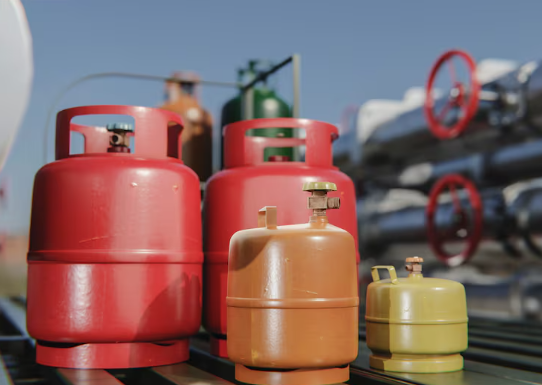When it comes to outdoor cooking, few things match the convenience and flavor of a gas barbecue. Whether you’re grilling for a family gathering or hosting a backyard party, having the right gas barbecue bottle is crucial. The bottle—or propane tank—is the heart of your grill’s fuel system. Choosing the wrong one can lead to inconsistent heat, safety risks, and higher costs.
This comprehensive guide will walk you through everything you need to know about choosing the right gas barbecue bottle for your grill — from size and material to safety, compatibility, and maintenance tips.
1. Understanding Gas Barbecue Bottles
Before selecting the right bottle, it’s important to understand what a gas barbecue bottle actually is. These bottles, also known as LPG cylinders, store liquefied petroleum gas (LPG), commonly propane or butane. The gas is stored under pressure and released in a controlled manner to fuel your barbecue’s burners.
There are two main types of gas commonly used in barbecues:
-
Propane – Performs well in all weather conditions, making it ideal for outdoor use year-round.
-
Butane – Suitable for warmer climates, but less efficient in cold weather.
Both gases provide clean-burning, controllable flames — but choosing between them depends on your grill type and usage needs.
2. Why the Right Gas Barbecue Bottle Matters
Choosing the right gas barbecue bottle isn’t just about convenience—it’s about performance, safety, and cost-efficiency.
Here’s why it matters:
-
Efficient Cooking: The correct bottle size and type ensure consistent gas flow and heat output.
-
Safety: Using a compatible bottle reduces risks of leaks or flare-ups.
-
Convenience: The right size means fewer interruptions during cooking.
-
Cost Savings: Properly sized bottles prevent wastage and overfilling.
In short, the right gas bottle makes your grilling experience smoother, safer, and more enjoyable.
3. Choosing the Right Gas Type: Propane vs. Butane
Let’s look closer at the two main gas options available for barbecues.
Propane (LPG)
-
Best for: Year-round use, especially in cold climates
-
Cylinder color: Usually red or orange
-
Boiling point: -42°C (works well in freezing temperatures)
-
Pressure: Higher pressure, delivering strong and steady flames
Propane is the top choice for most grillers because it performs consistently regardless of temperature. It’s ideal for large barbecues and outdoor kitchens.
Butane
-
Best for: Warm climates and portable camping barbecues
-
Cylinder color: Usually blue
-
Boiling point: -0.5°C (not suitable for cold conditions)
-
Pressure: Lower pressure compared to propane
Butane is perfect for smaller, portable barbecues where mobility and convenience matter more than power.
Pro Tip: If you grill throughout the year or live in a cooler region, choose propane. For occasional summer barbecues or travel, butane works fine.
4. Selecting the Right Size Gas Barbecue Bottle
Gas bottles come in various sizes. The right one depends on how often and how long you grill.
| Bottle Size | Typical Weight (Propane) | Best For |
|---|---|---|
| 5kg–6kg | Small/portable grills | Camping, picnics, small families |
| 9kg–11kg | Medium to large barbecues | Regular weekend grilling |
| 13kg–15kg | Heavy-duty grills | Frequent barbecuing, events, catering |
| 45kg+ | Built-in outdoor kitchens | Permanent setups and large gatherings |
Rule of thumb:
-
Occasional users (1–2 times a month) → Small 5–9kg bottle
-
Regular users (weekly) → 9–13kg bottle
-
Heavy users (daily or commercial) → 15kg or above
A larger gas barbecue bottle lasts longer but is heavier to move. If portability matters, a medium-sized bottle offers a good balance.
5. Compatibility: Regulator and Connection Type
Your grill’s gas regulator and hose connection must match the bottle type. This is crucial for safety and performance.
Common Connection Types
-
POL (Prest-O-Lite): Used for most propane cylinders; features a screw-in fitting.
-
Clip-on connectors: Often used for butane bottles; simple push-on mechanism.
Always check your barbecue’s user manual for the recommended connector type. If you’re unsure, your gas supplier or hardware store can help you find a compatible gas barbecue bottle and regulator.
Safety Tip: Never force a connection that doesn’t fit perfectly. Mismatched fittings can cause dangerous leaks.
6. Material: Steel vs. Composite Gas Bottles
Gas bottles are made from different materials, each with pros and cons.
Steel Bottles
-
Durable and robust
-
Less expensive
-
Heavier
-
Can corrode if not stored properly
Composite Bottles (Fiberglass)
-
Lightweight and easy to handle
-
Rust-free and semi-transparent (you can see gas level)
-
More expensive upfront
If you prioritize portability and appearance, composite bottles are a great modern choice. For long-term durability and budget-friendliness, steel bottles are perfectly reliable.
7. Safety Considerations When Choosing a Gas Barbecue Bottle
Safety should always come first when dealing with pressurized gas.
Here are key safety factors to consider:
-
Check for certification: Only buy bottles with safety approval marks from recognized authorities.
-
Inspect the bottle: Avoid damaged, rusted, or leaking cylinders.
-
Use upright: Always store and operate gas bottles upright to prevent liquid gas escape.
-
Proper ventilation: Never use your gas barbecue indoors or in enclosed spaces.
-
Avoid overfilling: Refill only from authorized gas suppliers.
Regularly inspect your hoses and regulators for wear and tear. Replacing them every 2–3 years ensures optimal safety.
8. Where to Buy or Refill Gas Barbecue Bottles
You can purchase or exchange gas barbecue bottles at:
-
Hardware stores
-
Gas retailers
-
Supermarkets with LPG sections
-
Authorized refill stations
Most retailers operate an exchange system — you bring in your empty bottle and swap it for a filled one at a discounted rate. This ensures your cylinder is always safe and certified.
When refilling, never attempt to fill a bottle yourself. Always use authorized refill stations that follow safety regulations.
9. Maintenance and Storage Tips
To extend the life of your gas barbecue bottle and ensure safety:
-
Store in a cool, dry place: Keep away from direct sunlight or heat sources.
-
Keep upright: Prevents gas leakage and maintains internal pressure balance.
-
Close the valve after use: Stops gas from escaping accidentally.
-
Check for leaks: Use a soapy water test—bubbles indicate a leak.
-
Protect from rust: Apply anti-rust spray or cover your steel bottle if stored outdoors.
Following these steps keeps your gas bottle in top condition and ready for your next barbecue.
10. How Long Does a Gas Barbecue Bottle Last?
The lifespan of a gas barbecue bottle depends on:
-
Bottle size
-
Grill BTU rating (fuel consumption)
-
Cooking duration and temperature settings
As a rough estimate:
-
A 9kg propane bottle lasts about 10–12 hours of cooking on a medium grill.
-
Smaller 5kg bottles may last 5–6 hours.
For regular grillers, it’s wise to keep a spare bottle on hand — nothing’s worse than running out of gas mid-barbecue!
11. Eco-Friendly Options: Refillable vs. Disposable Bottles
If sustainability is a concern, choose refillable gas bottles instead of disposable canisters. They are:
-
Environmentally friendly (less waste)
-
Cheaper long-term
-
Safer (regularly inspected during refills)
Disposable bottles are handy for camping but not ideal for frequent use. Refillable bottles are the better choice for home grills.
12. Expert Tips for First-Time Buyers
-
Buy from trusted suppliers: Ensure the bottle meets national safety standards.
-
Check compatibility: Match bottle gas type, regulator, and pressure to your grill.
-
Plan ahead: Estimate how often you’ll grill and choose the right size accordingly.
-
Keep a spare: Always have a backup bottle to avoid interruptions.
-
Label bottles: Mark propane and butane separately to avoid confusion.
13. Common Mistakes to Avoid
-
Mixing gas types (using butane instead of propane on the wrong regulator).
-
Ignoring expiry dates — bottles have a manufacturing date and must be recertified after 10–15 years.
-
Storing bottles indoors — always keep them outdoors, in shade, and away from flammable materials.
-
Laying bottles horizontally — always keep upright to prevent accidents.
-
Overtightening connections — it can damage seals and cause leaks.
Avoiding these mistakes keeps your grilling experience safe and stress-free.
14. Final Thoughts: Choosing the Best Gas Barbecue Bottle
Selecting the right gas barbecue bottle comes down to understanding your grill’s needs, usage habits, and safety priorities. For most home users, a 9kg propane bottle strikes the perfect balance of power, portability, and efficiency.
Always ensure compatibility between your grill and gas type, inspect your equipment regularly, and follow proper storage and maintenance practices. With the right bottle, you’ll enjoy effortless ignition, even heat, and hours of delicious outdoor cooking.
So, before your next cookout, double-check your setup — the right gas barbecue bottle can make all the difference between a good barbecue and a great one.

